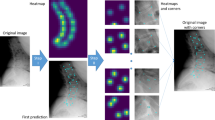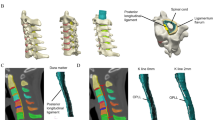Abstract
Clinical design:
A case report.
Objectives:
To elucidate the clinical role of snake-eyes appearance in this case, correlation between radiological, clinical and postmortem study was performed.
Setting:
Aichi, Japan.
Case report:
A 73-year-old man developed weakness and pain in the upper limbs due to kyphotic deformity secondary to laminectomy for cervical ossification of the posterior longitudinal ligament. Axial magnetic resonance imaging revealed snake-eyes appearance from C4 to C6. He died of acute myocardial infarction 3 months after anterior decompressive surgery.
Results:
A postmortem examination of the cervical spinal cord showed small cystic six necrotic areas at the junction of the central gray matter and the ventrolateral posterior column, one in the right and one in the left, in association with neuronal loss in the anterior horn.
Conclusions:
Bilateral small intramedullary high-signal areas known as ‘snake-eyes appearance’ located around the central gray matter and the ventrolateral posterior column, are associated with neuronal loss in the compressed anterior horn that played an important role in worsening weakness of the upper limbs.
Similar content being viewed by others
Log in or create a free account to read this content
Gain free access to this article, as well as selected content from this journal and more on nature.com
or
References
Mehalic TF, Pezzuti RT, Applebaum BI . Magnetic resonance imaging and cervical spondylotic myelopathy. Neurosurgery 1990; 26: 217.
Ramanauskas WL et al. MR imaging of compressive myelomalacia. J Comput Assist Tomogr 1989; 13: 399.
Takahashi M et al. Chronic cervical cord compression: clinical significance of increased intensity on MR images. Radiology 1989; 173: 219–224.
Yone K et al. Preoperative and postoperative magnetic resonance image evaluations of the spinal cord in cervical myelopathy. Spine 1992; 17: S388–S392.
Mizuno J et al. Surgical outcomes analysis of cervical OPLL and spondylosis patients with intrinsic high signal intensity lesions on MRI. Prog Comput Imaging 1999; 21: 5–11.
Wada E et al. Intramedullary changes of the spinal cord in cervical spondylotic myelopathy. Spine 1995; 20: 2226–2332.
Al-Mefty O et al. Myelopathic cervical spondylotic lesions demonstrated by magnetic resonance imaging. J Neurosurg 1988; 68: 217–222.
Matsuda Y et al. Increased MR signal intensity due to cervical meylopathy. J Neurosurg 1991; 74: 887–892.
Iwasaki Y et al. CT myelography with intramedullary enhancement in cervical spondylosis. J Neurosurg 1985; 63: 363–366.
Okada Y et al. Magnetic resonance imaging study on the results of surgery for cervical compression myelopathy. Spine 1993; 18: 2024–2029.
Bedford PD, Bosanquet FD, Russell WR . Degeneration of the spinal cord associated with cervical spondylosis. Lancet 1952; 2: 55–59.
Mair WGP, Druckman R . The pathology of spinal cord lesions and their relation to the clinical features in protrusions of cervical intervertebral discs. Brain 1953; 76: 70–91.
Ono K et al. Cervical myelopathy secondary to multiple spondylotic protrusions: a clinicopathological study. Spine 1977; 2: 109–125.
Murakami N, Muroga T, Sobue I . Cervical myelopathy due to ossification of the posterior longitudinal ligament: a clinicopathologic study. Arch Neurol 1978; 35: 33–36.
Author information
Authors and Affiliations
Rights and permissions
About this article
Cite this article
Mizuno, J., Nakagawa, H., Chang, HS. et al. Postmortem study of the spinal cord showing snake-eyes appearance due to damage by ossification of the posterior longitudinal ligament and kyphotic deformity. Spinal Cord 43, 503–507 (2005). https://doi.org/10.1038/sj.sc.3101727
Published:
Issue date:
DOI: https://doi.org/10.1038/sj.sc.3101727
Keywords
This article is cited by
-
Anterior horn damage in brachial multisegmental amyotrophy with superficial siderosis and dural tear: an autopsy case report
BMC Neurology (2023)
-
Human spinal cord tissue is an underutilised resource in degenerative cervical myelopathy: findings from a systematic review of human autopsies
Acta Neurochirurgica (2023)
-
Magnetic resonance imaging and dynamic X-ray’s correlations with dynamic electrophysiological findings in cervical spondylotic myelopathy: a retrospective cohort study
BMC Neurology (2020)
-
Inflammatory cascades mediate synapse elimination in spinal cord compression
Journal of Neuroinflammation (2014)
-
Clinical significance of MRI/18F-FDG PET fusion imaging of the spinal cord in patients with cervical compressive myelopathy
European Journal of Nuclear Medicine and Molecular Imaging (2012)



